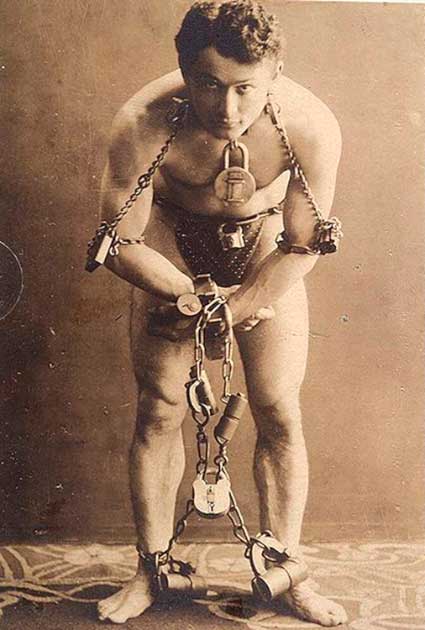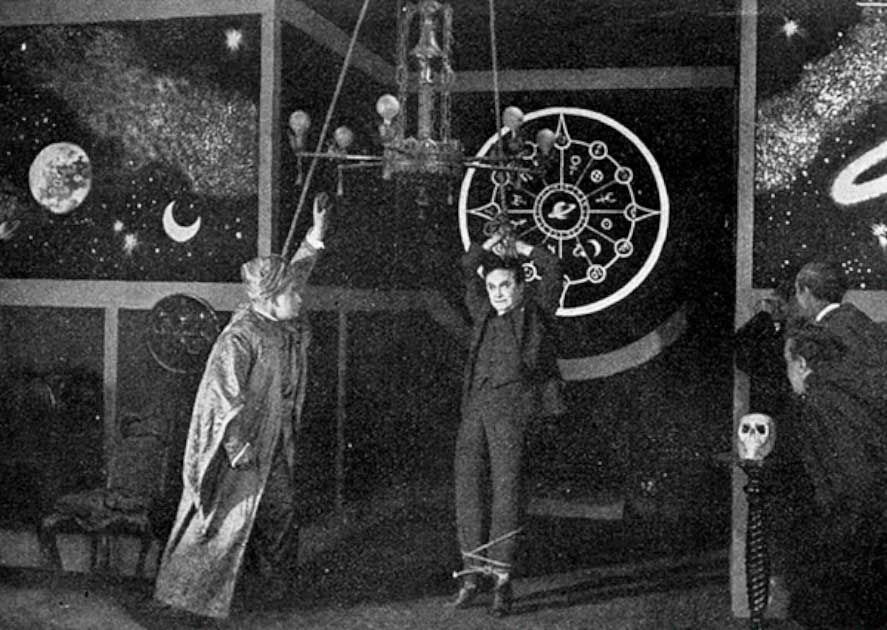Erik Weisz, better known as Harry Houdini, was born on March 24th, 1874. A Hungarian American, he is best known for being an escape artist, magic user, and stunt performer. Houdini became most famous for his escape acts. The name itself came from his spiritual and magic idol, Jean-Eugene Robert-Houdin, who lived between 1805 and 1871.
Harry Houdini first attracted attention in the United States when performing in the vaudeville, a theatrical genre of variety entertainment. His success here would lead him to travel Europe challenging various police forces to lock him up.
Later he would include chains, ropes, and straitjackets in his act. Through his success, Harry Houdini became President of the Society of American Magicians and also became an actor, only to quit when it became less profitable than his escapes. He tried his hand at aviation, but it is as a escape artist that he will be forever remembered.
Early Years
Erik Weisz was born in Hungary in Budapest to a strictly Jewish family. His father was Rabbi Mayer Samuel Weisz, and his mother was Cecilia Steiner. Erik had six siblings.
He first arrived in the United States at age 4 with his mother and four of his brothers. They lived in Appleton Wisconsin where Samuel could serve as a Rabbi to the Zion Reform Jewish Congregation.

Life was not easy however and by 1882, the Weisz family fell on hard times. They moved to Milwaukee and fell into poverty. In 1887, Erik along with his father moved to New York City where he worked many jobs including his public debt as a trapeze artist at just age nine. Along with this talent, he also showed that he had a penchant for running, becoming a champion cross-country runner in his time in New York.
You’re a Wizard Harry
Weisz became a professional magician in 1891, while still a teenager. He began calling himself Harry Houdini after the French magician Jean-Eugene Robert-Houdin. Harry had read his autobiography the year before.
- History of Magic from Dark Art to Pop Entertainment
- Shot To Fame! Rossa Matilda Richter, The First Human Cannonball
He had believed that by adding the “i” to the end of the name, he was indicating that he was “like” Robert-Houdin. He also claimed that the Harry part of his name came from his admiration of Harry Kellar, but it may have also stemmed from his nickname as a child: “Ehri”.
In his teenage years, Harry was trained by Joseph Rinn at the Pastime Athletic Club, and it was not long until he appeared in his first act with strongman Emil Jarrow. Harry spent much of his time performing in sideshows and the circus focusing on traditional card tricks. He was competent at this but nowhere near as skilled as other professionals in the game. Harry decided to switch to escape acts.
Houdini’s biggest break would come in 1899 when he was spotted by manager Martin Beck who was impressed by Houdini’s handcuff acts and told him he should concentrate on these. Within months, Houdini was performing around the country at the top vaudeville houses before embarking on a European tour.
Initially, Harry struggled in his first stop in London but was able to impress Scotland Yard when he demonstrated how he could easily escape from the handcuffs there. Harry Houdini went on to tour Britain for the next 20 years, demonstrating illusions, stunts, card tricks, and most importantly his escape acts.
Notable Escapes
Harry Houdini understood how to wow his audience, and participated in a series of highly sensationalized escape acts, each seemingly more dangerous than the last. Here are some of his most famous acts:

The Daily Mirror Challenge: In 1904, the London-based paper The Daily Mirror challenged Houdini to escape special handcuffs that Nathaniel Hart, a locksmith, had spent 5 years working on. It was a massively hyped event and it almost seemed to defeat Houdini as it took him over an hour to escape.
He asked for his coat to be removed but this request was refused. Using a penknife, he cut it from his body. In total, it took him 70 minutes to escape after which he cried and claimed it had been one of the most difficult escapes of his career.
- The Magician Who Never Was: The Great Bottle Conjuror of 1749
- Isaac Newton and the Occult: What Secrets did the Great Man Uncover?
The Milk Can Escape: In 1908, Harry Houdini introduced a unique and challenging act: the Milk Can Escape. In it, Houdini was handcuffed and sealed inside an oversized milk can filled with water. To bring the audience along with him, he invited them to hold their breath alongside him advertising that his failure to escape would invite death. He would go on to adapt this act over the years, introducing padlocks and wooden chests.
The Chinese Water Torture Cell: Due to the popularity of his “Milk Can Escape” act and the many people who tried to imitate it, Houdini was forced to replace it with the “Chinese Water Torture Cell”. In this act, Harry would be locked, upside down in stocks to a tank of water.
These were lowered down to seal him in. The stocks were locked to the top of the cell and a curtain was used to conceal his escape. The stocks also meant that he could not turn and there were bars around the outside that offered protection if the glass was to be broken. He first performed this act in England so that he could obtain copyright protection so that he could sue any imitators.
Harry Houdini’s Death
However, for all his skills as a magician, Houdini would die before his time in an almost ridiculous fashion. On October 22nd, 1926, two University students visited Harry in his dressing room. One of them, J. Gordon Whitehead, wanted to put to the test the idea that Houdini could withstand any blow to the abdomen.

Harry said it was true if he had time to brace himself. Whitehead proceeded to punch Houdini four times in the abdomen, though these landed before Houdini could brace himself. Houdini performed throughout the night in great pain, and was unable to sleep, but he did not seek medical help.
When the doctors did arrive during a break, Houdini had a fever of 102 degrees and acute appendicitis. Despite this, Harry decided to complete the performance. He did not make it through the show, however, collapsing midway through. His appendix had ruptured and killed him.
As to how he performed all these escapes? Harry never told, and neither shall we.
Top Image: Flyer for Harry Houdini’s act performed in Germany in 1908. Source: Unknown Author / Public Domain.
By Kurt Readman